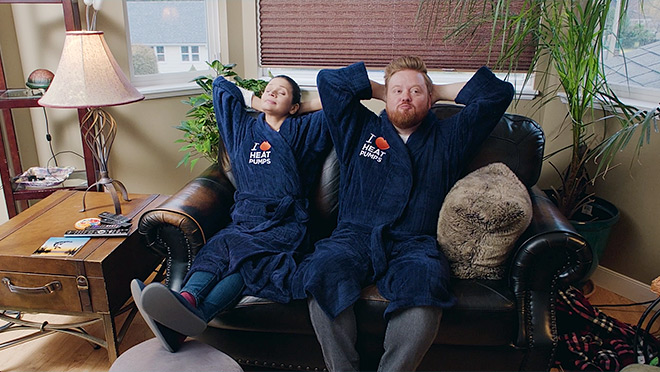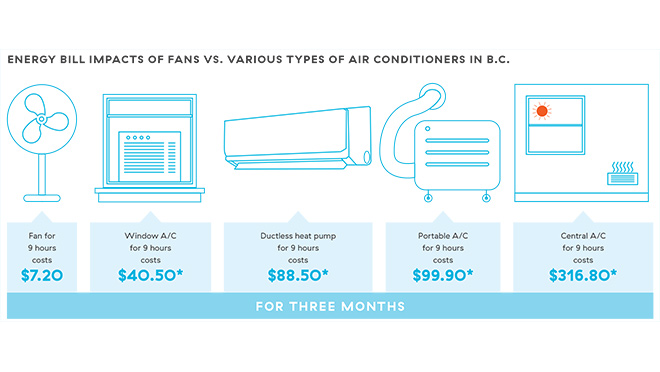Happy at home: 10 ways to up your comfort, health

Tips on air, water and light... and for a good night's sleep
It would be a mistake to sacrifice home comfort in the name of energy efficiency. The good news is that being smart about energy use, and staying comfortable and healthy go hand-in-hand.
There are now interior designers who focus on designing for physical and mental wellness. There's even an international organization (International Well Building Institute) that advises commercial and residential building developers and designers on how to increase the wellness factor in living and working spaces.
And thanks to all that time spent inside our homes during the COVID-19 pandemic, we now have a fuller appreciation for wellness in the home.
"Instead of looking at our homes as being a place to live, they need to be designed for life," said Brett Stenner, a North Vancouver-based home technology specialist, as a guest of a Homebuilders Association of Vancouver podcast in 2021.
Stenner's firm, CI Partners, became WELL AP Certified by the Well Building Institute, which embraces seven categories of wellness: air, water, nourishment, light, fitness, comfort, and mind. In his own home, Stenner makes music a near constant presence, with speakers embedded in his ceilings. But of those seven WELL AP factors, he sees air, water, and light as most relevant to health and comfort in residences.
We chatted with both Stenner and BC Hydro engineer Gary Hamer, and leaned on an assortment of other resources, to provide you with some insights into how to make your home more comfortable and healthy.
1. Use sunlight as much as possible
Daylight and sunlight don't just cut down on how much we use artificial light in our homes. They also lift our mood. Open blinds and window coverings to invite sunshine's light and warmth into the home, but close them when you need privacy or when it's getting hot outside and you need to keep your home cool.
Set up comfortable seating near south and west facing windows to take full advantage of the light that spills in. And consider automated blinds that, while pricey, can be programmed or use sensors to adjust automatically at different times of the day.
2. Consider a heat pump for comfort and health
The year-round benefits of replacing your gas furnace or electric baseboard system with an air-source heat pump make them increasingly popular.
You'll feel more comfortable when your home’s kept at the ideal temperature year-round. You can rely on a heat pump to deliver "set it and forget it" control in all seasons, including cooling in the summer. Heat pumps can also increase your comfort by helping control indoor humidity levels.
Combined provincial and federal rebates of up to $11,000 are available for switching from fossil fuel heat to a heat pump. And rebates of up to $7,000 are available when you switch from baseboard electric heating to a heat pump.
3. Use smart thermostats with baseboard heating
Baseboard electric heat works best, and can cost less to run, when thermostats are adjusted regularly to save on heating overnight, when you're away, and in rooms that aren't being used. Striking a balance between energy savings and comfort is easiest with smart thermostats, which can be programmed to reflect your daily schedules.
Using a smart thermostat effectively can help you save money on your energy bill. Programming to lower heat in unused rooms, overnight and when you're away could pay for the purchase of wifi thermostats in two years or less.
4. Don't let light mess with your sleep cycle
"Light has a major effect on our sleep patterns because we’re geared to follow the sun," says Stenner. "So we have a circadian rhythm to our body that tells us to be the most alert during the middle of the day and to start feeling sleepy at night because it’s time for bed."
But light in the evenings, from smartphones, TVs, and other devices that emit bluish light, can mess things up. Avoid them later in the evening and, if you like to read in bed, consider using an e-reader in night mode that emits soft, yellowish light that helps you ease to sleep.
To enjoy a night of uninterrupted sleep, consider using blackout drapes or blinds that allow you to avoid the wakeup call of morning light. And use a night light, dimmers, or other lighting controls in your bathrooms to avoid a shock to the system if you have to get up to use the bathroom in the middle of the night.
5. If you crack a window open for fresh air, close the bedroom door
A lot of us sleep more soundly when outside air flows directly into our bedrooms, and we want it year round.
"If a home doesn’t have a whole home ventilation system, such as a heat recovery ventilator (HRV) or energy recovery ventilator (ERV), a cracked window is a good option to get fresh air throughout the year," says BC Hydro's Hamer. "But that's provided the bedroom door is kept closed to limit the heat loss from the rest of the house, and the window is not opened too much. It can take a bit of trial and error to get it right but a window can be an effective way to get rid of the carbon dioxide and moisture we exhale, and allow the fresh air (oxygen) we need for a restful sleep."
6. Replace that gas stove, or always use a fan
Amid growing concerns over the health effects of gas stoves, and a move away from fossil fuels, more people are switching to the ease and efficiency of electric induction stoves.
While it is always a good practice to use a range hood to remove moisture and oils of cooking, it is particularly important to turn it on with a gas stove to exhaust the combustion products directly outside. When possible, use the back burners of the gas stove to maximize the fan's effectiveness.
7. Off-gassing worries? Go low-VOC or buy second-hand stuff
Whenever you smell a product in your home, it's off-gassing. Chemicals that off gas from vinyl flooring, carpeting, furniture, paint, and other products aren’t good for us, and they can persist for months, even after that new-product smell disappears. If you want to avoid those potential side-effects, some health experts recommend buying second-hand furniture.
It's possible to buy no- or low-VOC (volatile organic compound) paints, furniture, cleaning fluids, and other products for the home.
8. Use fans regularly to eliminate condensation
Water condensing on your windows is a sign of potential concern. While it can happen occasionally from cooking or large gatherings, regular occurrences increase the risk of mould and mildew growths that can lead to health issues. Use kitchen and bathroom fans regularly to remove excessive moisture in your home.
That means leaving bathroom fans on long after you've finished your shower, as moisture from walls and wet towels will otherwise gravitate to the closest cool surface, often your windows or cool corners. And even the breathing of two people in a bedroom overnight can create condensation issues that can be corrected by leaving a fan on in an adjacent bathroom overnight.
BC Hydro's Hamer says getting the right size and model of fans is vital to successful operation. A quieter fan – particularly range hood fans – are more likely to be used.
"A bathroom fan’s effectiveness can be easily tested by turning it on and holding a paper up to the grill," says Hamer. "If the paper stays in place the fan is working – at least at some level. If it is not working well, it might just need a cleaning. Along with moisture, the fan will exhaust dust that can build up on the fan over time."
9. Use window coverings, air flow to stay cool
A heat pump is a great way to stay cool in the summer, but even without one, a strategic approach to cooling can keep you cool and happy at home.
"If possible, shade the room from the sunlight that could overheat a room," says Hamer. "An outside shade prevents that infrared heat (from the sun) from hitting the window glass or wall, and is much more efficient at preventing overheating than an inside shade or blind."
Hamer says a portable or room air conditioner can work well in rooms where you spend most of your time, including in bedrooms while you sleep. Also consider using fans (ceiling or portable) that cool occupants directly and/or to open a window when the outside air is cooler than the air in your home. Just make sure to close all windows and doors before the outside air starts to heat up in the morning.
10. Check the temperature and purity of your water
Water quality out of taps in most B.C. homes is excellent, but impurities can happen. Ash and debris from wildfires, and algae blooms in reservoirs brought on by hot weather can make it harder for the local water treatment system to keep your drinking water safe.
You'll likely hear from your water supplier if there's a problem with the quality of drinking water. If you're concerned with ongoing issues over water purity, consider either installing a water purifier under your sink, or use a water jug filter (such as a Brita) for drinking water you keep in your fridge.
"Municipalities generally do a great job of managing water quality, but well water can be hit and miss," says Hamer. "A water quality specialist should be sought if you're ever in doubt."
Water too hot from your taps can cause scalding – children and elders are most susceptible – so check to ensure that the temperature of the water is hot enough for hygiene but low enough to be safe. On most water heaters the temperature can be adjusted.
"Canadian standards for setting the temperature in water heaters balance the need to protect occupants from hot water scalding and the need to heat the water sufficiently to prevent the growth of harmful bacteria," says Hamer. "Tempering valves can be installed to prevent scalding at sinks or tubs if the delivered water temperature at a particular faucet is too high."
Related:

